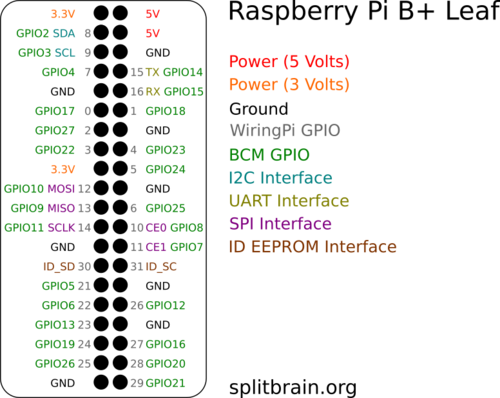|
|
| Linha 1: |
Linha 1: |
| =Raspberry Pi GPIO= | | =Raspberry Pi: GPIO= |
|
| |
|
| | [[Raspberry Pi: Programacao GPIO com Python|Raspberry Pi: Programação GPIO com Python]] |
| ==Pinagem GPIO== | | ==Pinagem GPIO== |
| *https://www.raspberrypi.org/documentation/usage/gpio/ | | *https://www.raspberrypi.org/documentation/usage/gpio/ |
| Linha 106: |
Linha 107: |
|
| |
|
| ==Programação Python para controle GPIO== | | ==Programação Python para controle GPIO== |
| | | *[[Raspberry Pi: Programacao GPIO com Python|'''Raspberry Pi: Programação GPIO com Python''']] |
| ===Biblioteca RPi.GPIO===
| |
| | |
| A biblioteca '''RPi.GPIO''' <ref>https://pypi.org/project/RPi.GPIO/</ref> é um módulo de controle para as portas '''GPIO''' do '''Raspberry Pi''' usando linguagem '''Python'''. Entretanto, está biblioteca não é apropriada para aplicações tempo real ou com restrições temporais, pois roda sobre o ''kernel'' Linux, o qual não apropriado para aplicações tempo real. A versão atual desta biblioteca não suporta SPI, I2C, hardware PWM ou interface serial.
| |
| | |
| ;Procedimentos para uso:
| |
| :Verificar se a biblioteca '''rpi.gpio''' está instalada: | |
| apt list --installed | grep rpi.gpio
| |
| :Importar biblioteca no '''interpretador''' ou '''código Python''':
| |
| <syntaxhighlight lang="python">
| |
| import RPi.GPIO as GPIO # Importa o módulo RPi.GPIO e usa localmente o nome GPIO para referenciá-lo.
| |
| </syntaxhighlight>
| |
| | |
| ;Programa para piscar led:
| |
| | |
| Código Python <ref>https://www.electrofun.pt/blog/curso-raspberry-pi-14-python-basico-gpio/</ref>:
| |
| | |
| <syntaxhighlight lang="python">
| |
| import RPi.GPIO as GPIO
| |
| from time import *
| |
|
| |
| GPIO.setmode(GPIO.BCM) # Numeração nomes GPIO
| |
| #GPIO.setmode(GPIO.BOARD) # Numeração pinagem da placa
| |
| GPIO.setup(17, GPIO.OUT)
| |
|
| |
| while True:
| |
| GPIO.output(17, GPIO.HIGH)
| |
| print("Led ON")
| |
| sleep(1)
| |
| GPIO.output(17, GPIO.LOW)
| |
| print("Led OFF")
| |
| sleep(1)
| |
| </syntaxhighlight>
| |
| | |
| ;Programa para ler chave ''pull-up'' e acionar led: Chave conectada ao pino 18 (entrada ''pull-up'') e led ao pino 17 (saída).
| |
| | |
| <syntaxhighlight lang="python">
| |
| import RPi.GPIO as GPIO
| |
| from time import sleep
| |
|
| |
| GPIO.setmode(GPIO.BCM)
| |
| GPIO.setup(18, GPIO.IN, pull_up_down=GPIO.PUD_UP)
| |
| GPIO.setup(17, GPIO.OUT)
| |
|
| |
| while True:
| |
| if GPIO.input(18):
| |
| print("Led ON")
| |
| GPIO.output(17, 1)
| |
| else:
| |
| print("Led OFF")
| |
| GPIO.output(17, 0)
| |
| sleep(0.1)
| |
| </syntaxhighlight>
| |
| | |
| ==Biblioteca Gpio Zero==
| |
| | |
| A biblioteca '''Gpio Zero''' <ref>https://gpiozero.readthedocs.io/en/stable/</ref> é uma interface GPIO para uso com o Raspberry Pi. Esta biblioteca é instalada por ''default'' no Raspberry Pi.
| |
| | |
| Exemplos<ref>https://www.raspberrypi.org/documentation/usage/gpio/python/README.md</ref>:
| |
| | |
| ;Programa para piscar led:
| |
| <syntaxhighlight lang="python">
| |
| from gpiozero import LED
| |
| from time import sleep
| |
| | |
| led = LED(17)
| |
| while True:
| |
| led.on()
| |
| sleep(0.5)
| |
| led.off()
| |
| sleep(0.5)
| |
| </syntaxhighlight>
| |
| | |
| ;Programa para ler chave:
| |
| <syntaxhighlight lang="python">
| |
| from gpiozero import Button
| |
| from time import sleep
| |
| | |
| button = Button(2)
| |
| while True:
| |
| if button.is_pressed:
| |
| print("Pressed")
| |
| else:
| |
| print("Released")
| |
| sleep(1)
| |
| </syntaxhighlight>
| |
| | |
| ===Biblioteca CircuitPython===
| |
| | |
| A biblioteca '''CircuitPython''', da '''Adafruit''', é uma versão amigável e ''open source'' do Python, especialmente desenvolvida para microcontroladores e pequenos dispositivos <ref>https://circuitpython.readthedocs.io/en/5.3.x/README.html</ref>.
| |
| | |
| O '''CircuitPython''' adiciona a parte de circuitos ao Python, permitindo que o Python converse com sensores, motores, Leds e outros dispositivos.
| |
| | |
| Esta biblioteca suporta '''I2C''' e '''SPI''', os quais precisam ser habilitados.
| |
| | |
| Confira os procedimentos para instalação do '''CircuitPython''' e exemplos em <ref>https://www.digikey.com/en/maker/projects/circuitpython-on-linux-and-raspberry-pi/2aac644c44f1418e987417b229a67c23?utm_adgroup=Adafruit&utm_source=google&utm_medium=cpc&utm_campaign=Dynamic%20Search_EN_Suppliers&utm_term=&utm_content=Adafruit&gclid=Cj0KCQjwg8n5BRCdARIsALxKb972kt1RhdKJR7h8JvQnJQtVGCfBbIZ0vAjN_GvyKyLOkDGq11ctO4kaAtNaEALw_wcB</ref>.
| |
| | |
| ;Piscar led: Led conectado a saída GPIO 17.
| |
| <syntaxhighlight lang="python">
| |
| import time
| |
| import board
| |
| import digitalio
| |
| | |
| print("hello blinky!")
| |
| | |
| led = digitalio.DigitalInOut(board.D17)
| |
| led.direction = digitalio.Direction.OUTPUT
| |
| | |
| while True:
| |
| led.value = True
| |
| time.sleep(0.5)
| |
| led.value = False
| |
| time.sleep(0.5)
| |
| </syntaxhighlight>
| |
| | |
| ;Chave digital: Chave na entrada GPIO 18 e led na saída GPIO 17.
| |
| <syntaxhighlight lang="python">
| |
| import time
| |
| import board
| |
| import digitalio
| |
| | |
| print("press the button!")
| |
| | |
| led = digitalio.DigitalInOut(board.D17)
| |
| led.direction = digitalio.Direction.OUTPUT
| |
| | |
| button = digitalio.DigitalInOut(board.D18)
| |
| button.direction = digitalio.Direction.INPUT
| |
| button.pull = digitalio.Pull.UP
| |
| | |
| while True:
| |
| led.value = not button.value # light when button is pressed!
| |
| </syntaxhighlight>
| |
|
| |
|
| ==Interação entre Raspberry Pi e Node-RED== | | ==Interação entre Raspberry Pi e Node-RED== |
|
| |
|
| *[http://wiki.foz.ifpr.edu.br/wiki/index.php/Node-RED_Laboratorios:_Raspberry_Pi|'''Node-RED Laboratorios: Raspberry Pi'''] | | *[[Node-RED Laboratorios: Raspberry Pi|'''Node-RED Laboratorios: Raspberry Pi''']] |
|
| |
|
| ==Referências== | | ==Referências== |
Raspberry Pi: GPIO
Raspberry Pi: Programação GPIO com Python
Pinagem GPIO

- Comando via terminal:
pi@raspberrypi:~ $ pinout
Acesso aos drives GPIO pelo terminal
- Exemplo de acionamento de led [1]
- Pino GPIO 21
Acesso aos drives de controle dos pinos GPIO e verificar se o pino está ativo
cd /sys/class/gpio/
ls
Se não estiver ativo, ativar com o comando
echo 21 > /sys/class/gpio/export
Configurar o pino como saída (default entrada)
echo out > /sys/class/gpio/gpio21/direction
Acionar led com 0 (LOW) ou 1 (HIGH):
echo 1 > /sys/class/gpio/gpio21/value
echo 0 > /sys/class/gpio/gpio21/value
Desativar acesso ao pino:
echo 21 > /sys/class/gpio/unexport
Programa GPIO
O biblioteca WiringPi fornece comandos para acesso direto aos pinos GPIO do Raspberry Pi [2].
Para verificar a versão instalada:
gpio -v
Para atualizar a versão:
cd /tmp
wget https://project-downloads.drogon.net/wiringpi-latest.deb
sudo dpkg -i wiringpi-latest.deb
Ajuda para comandos:
man gpio
Verificação do estado atual dos pinos gpio:
gpio readall
Saídas digitais
- Acionamento de led
- Pino GPIO 17 (físico 11)
gpio -g mode 17 out
gpio -g write 17 1
gpio -g write 17 0
- O parâmetro -g indica numeração dos pinos BCM_GPIO (na caso de -i indica numeração física dos pinos).
- Piscar led
gpio -g blink 17
- Script para piscar led [1]
- Usar editor de textos e salvar como blink.sh
#!/bin/sh
gpio -g mode 17 out
while true
do
gpio -g write 17 1
sleep 1
gpio -g write 17 0
sleep 1
done
Dar permissão de execução:
chmod +x blink.sh
Saídas PWM
Uma saída PWM gera uma onda quadrada, com frequência constante, em que a fração de tempo em que o sinal é HIGH (3,3 V) pode variar entre 0 e 100% (duty cycle), fornecendo uma média de tensão variável na saída. O controle do duty cycle no Raspberry Pi usa 10 bits e pode ser variado de 0 a 1024.
No Raspberry Pi os pinos GPIO12, GPIO13, GPIO18 e GPIO19 aceitam saída PWM.
- Controle da luminosidade de um led
- Pino GPIO 18
gpio -g mode 18 pwm
Luminosidade máxima:
gpio -g pwm 18 1024
Luminosidade média:
gpio -g pwm 18 512
Luminosidade mínima:
gpio -g pwm 18 0
Entradas digitais
Um pino GPIO configurado como entrada digital pode ler valores HIGH (3V3) ou LOW (0V).
Também podem ser utilizados os resistores internos pull-up ou pull-down. Os pinos GPIO2 e GPIO3 tem resistores pull-up fixos, os demais podem ser configurados por software.
- Exemplo chave eletrônica e uso de resistor pull-up interno
- pino 26: Com a chave aberta o pino recebe HIGH através do resistor pull-up. Com a chave fechada o pino recebe LOW.

Configuração:
gpio -g mode 26 up
Leitura:
gpio -g read 26
Módulos externos para entradas e saídas analógicas
O Raspberry Pi não possui pinos para entradas analógicas, para tal é necessário especificar um módulo externo e o parâmetro -x.
Exemplos:
gpio -x mcp3002:200:0 aread 200 # Módulo ADC mcp3002
gpio -x mcp4802:200:0 awrite 200 128 # Módulo DAC mcp4802
Exemplos conexão de módulos externos ADC [3] e DAC [4] ao Raspberry Pi.
Programação Python para controle GPIO
Interação entre Raspberry Pi e Node-RED
Referências
Evandro.cantu (discussão) 14h44min de 11 de fevereiro de 2022 (-03)

